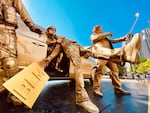Following the killing of George Floyd in May 2020, protests against systemic racism and police brutality swept across the country. And with them came a renewed push to remove monuments and memorials of Confederate leaders and others entrenched in racist ideology.
Some came down through a vote from the U.S. House of Representatives, while others were toppled by protesters taking things into their own hands.
But while controversial statues, building names and paintings are being largely removed from the public eye, in Portland, a new set of monuments went up, if only for a few hours.

A piece from the Trump Statue Initiative depicts federal law enforcement officers pulling a Black Lives Matter protester into an unmarked van while the President takes a selfie.
Courtesy of the artist / Trump Statue Initiative
They were three life-sized gold figures depicting President Donald Trump and federal officers, all satirizing events that happened in the last month.
But the monuments are not permanent. And those life-sized figures? They were actors, painted gold from head-to-toe as part of the Trump Statue Initiative.
It’s the brainchild of Bryan Buckley, a filmmaker and Academy Award-nominee whose widespread commercial work gained him the nickname “King of the Super Bowl” from The New York Times. Buckley is a long-time activist, and his narrative work includes the short film “Saria,” which explores the days leading up the 2017 fire in a Guatemala orphanage which killed 41 girls.
The Portland exhibit, titled “Ode To Putin,” unfolded in three parts across the city’s Tom McCall Waterfront Park and critiqued recent Trump Administration actions.
The first statue depicts federal law enforcement officers pulling a Black Lives Matter protester into an unmarked van while the President takes a selfie.
The second references President Trump’s ongoing criticism of mail-in voting. Titled “Some Federal Property We Can Attack,” it shows Trump and three armed officers in gas masks surrounding a mailbox.
The name of the third piece, “I Just Wish Her Well Frankly,” is a direct quote from President Trump when questioned about Ghislaine Maxwell at a White House coronavirus briefing. Maxwell has been charged with sex trafficking in connection to her former boyfriend, the late sex offender Jeffrey Epstein. The statue depicts the faux Trump praying over a real-life photo of the president alongside the two accused child sex traffickers.
OPB’s Crystal Ligori spoke with Buckley about how the Trump Statue Initiative started, getting the project to Portland and what impact he wants it to have.
On creating the Trump Statue Initiative
“When the Lafayette Square moment happened, it was a really jarring moment for me personally. I had been doing projections [on buildings] in New York City, but that moment at the church was so powerful. ... I felt like, if we could take these statues and connect the humanity to them, it’s really interesting.”
On art as a form of protest
“People’s minds open up with art, and you can get in there and make people think. [Art] can infiltrate the brain in such an unusual manner and people are more receptive to it. The statues that we have, they create their own noise. ... And at this point in time, I think we need that hope of art. It’s a very dark time and we need something to break through and I think art can do that.”
Why Portland?
“Unfortunately, we don’t pick the stops. The president seems to pick the stops for us. We’re sort of like the fire department: We react to what Trump does, and then we race to that moment.”
“We started in D.C. for obvious reasons, but when the federal agents went out into the streets [in Portland] and started ripping protesters off the streets, to me it was absolutely outrageous. So I was just like, we have to get up there and we’re going to make a statement.”
On the impact they hope to have
“The initial concept [of the Trump Statue Initiative] is to drive voting — that is our goal. A big part of our core message is to go register, [so] we’re going right through to the election.”
“We’re going to swing states, to get people to think and to get that turnout. So we’re probably gonna head into, maybe less friendly areas than Portland was to our exhibit. We have to go to those more difficult places that might not be as receptive to messages that were pushing out there.”



